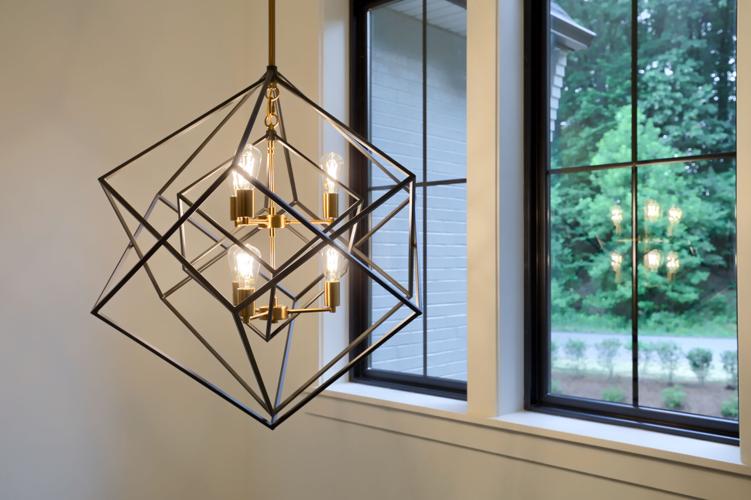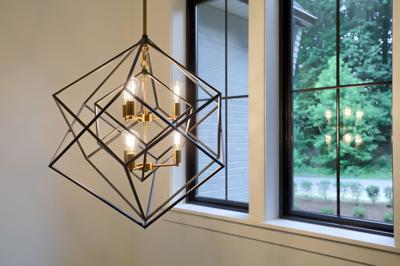Interior designer Ron Tschudy calls them sculptures. Nicole Enck, sales manager and designer for Pine Hill Building Co. in Lititz, likens them to jewelry, while Lancaster business owner Carol Haas credits them with creating ambiance. Interior designer Henrietta Heisler says they can change a room.
The four are describing lighting choices, something they say is an often overlooked area when people are building, updating or adding some personality to a home. Local industry experts say the latest trends in lighting can express a person’s artistic style and elevate a dwelling from a cookie-cutter home into something spectacular.
“It’s amazing what you can do with lights,” says Haas, who, with husband James, owns The Lighting Gallery, a 5,000-square-foot Lancaster store dedicated to illumination.
“There’s a tremendous amount of choice out there,” says Heisler, president of Lancaster-based Henrietta Heisler Interiors.
Want advice on the latest lighting styles? Read on.
Mixed metals
Manufacturers now combine different finishes, Haas says. Look for black with gold, or brushed nickel with antique brass.
Don’t be afraid to experiment, says Tschudy, who works with Nathan Mayo & Associates in Shillington.
As Enck explains, “You won’t see all black anymore.”
Heisler says mixed-metal fixtures achieve a modern vibe.
“They definitely have an industrial look,” she says.
Choose your bulb
Thank Thomas Edison for incandescent bulbs. A tungsten filament inside a gas-filled bulb glows when an electric current runs through it. While these bulbs create a warm, flattering light, they also give off heat and are less energy efficient than LED bulbs, which use semiconductors to create light. LED bulbs also last much longer.
Customers now flock to Edison-style bulbs, Haas says. They can skip the heat, though, because many companies now make LED bulbs that feature a glowing filament.
“People want to see the bulb in the fixture,” Haas says.
Warm or cool?
Lights used to be about wattage — which measures electrical output. With LEDs, experts now talk about lumens, which measure brightness. The higher the lumens, the higher the level of brightness. Most customers like between 2,700-3,400 lumens in homes, designers say.
Hospital lights may reach about 5,000 lumens, Heisler says.
“White light can be pretty,” the designer says. “It’s better for the environment and better for your pocketbook.”
One of her clients disagrees.
Don’t mention LEDs to Brenda Wissler, of Lititz.
“I’m (for) the warm traditional light coming out of the fixture,” she says. “Warm light is more peaceful.”
Wissler and husband Bill recently built a five-bedroom house in Dover Beach, Delaware, and also closed on a two-bedroom condo in Lititz. Soft, warm lighting fills both homes. Wissler researched lighting options after reading an article in a magazine.
Go clear
Frosted glass screams yesterday, Haas says. Instead, opt for clear or seeded glass.
“You want to see the bulbs in the fixture,” she says. “Everyone is getting on that bandwagon.”
Wissler used seeded glass globes to hang over her kitchen island at the beach.
“I wanted more lighting,” she says. “I bought a lot of seeded glass.”

Pine Hill Building Co. went for the wow factor with these oversized picnic basket-style lights in the kitchen of a home in Lebanon County's Iron Valley community. The Parade of Homes entry was this year's Fulton Award winner.
Go big
Think of a large light fixture that would make a statement. Now, think of a larger one, lighting designers say.
“You’re going for the wow factor,” Enck explains.
She used two large gold picnic-style baskets over a kitchen island and then another two over the breakfast bar in a two-story Lebanon home. She also placed an oversized statement piece in the foyer of that home in the Iron Valley community.
The residence won top honors at the 2021 Lancaster/Lebanon Parade of Homes for single-family dwellings that cost more than $853,900.
“You want something people will see when they walk in,” Enck explains.
Rod Weaver agrees. “People get things that are too small,” says Weaver, who owns American Period Lighting, a Lancaster manufacturer that makes reproductions of light fixtures.
Weaver has seen his clientele move away from old-fashioned lighting choices inside their homes to using pieces he makes for outdoors.
Be creative
“Find something unique,” Heisler advises. “There are so many beautiful lights.”
She and Tschudy recommend searching for curved fixtures as well as square or rectangular ones. Also, be consistent with style, experts say. There’s nothing wrong with traditional-looking fixtures, but spread that theme around a home.
Also, don’t be afraid to be different, Tschudy advises. For instance, consider sconces in a master bedroom. Touches like these can personalize a home, making it look different from others in the neighborhood. In addition, use dimmers to control the level of light.
“Dimmers are a neglected option,” Tschudy says.

Make a statement in a grand foyer, like this oversized piece in a Parade of Homes entry by Pine Hill Building Co.
Be square
Older recessed lights use a round hole in a ceiling, with 6 inches around each incandescent bulb to handle the heat, Tschudy says. A new trend features square LED lights that can be mounted flush on a ceiling. These disc or wafer lights cut down on installation costs and draw attention away from the bulb housing, creating a streamlined look, the he says.
Carry that square or rectangular shape into other areas of the home, Tschudy says. For instance, consider a square chandelier in the dining room.
“How many people have rectangular or square dining tables?” Tschudy asks. “Unique contemporary looks can give you a piece of art in your home.”
He also advises consumers to look at starburst shapes and orbs.
Be realistic
Wissler knows that incandescent bulbs are becoming harder to find as the industry moves toward LEDs. She soon will have to replace some of her incandescent bulbs with newer LEDS. She’s already started her research and found LED wafer bulbs with 2,700 lumens.
“I don’t want industrial-looking lights.”







